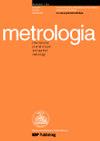CIPM 列表 "标准频率建议值":2021 年更新
IF 2.4
3区 工程技术
Q2 INSTRUMENTS & INSTRUMENTATION
引用次数: 0
摘要
本文详细介绍了对国际计量委员会建议的标准参考频率值清单进行 2021 年更新所依据的分析。此次更新的重点是作为二次代表(SRS)或被视为潜在 SRS 的原子跃迁子集。与之前 2015 年和 2017 年的更新一样,采用了分析超定数据集的方法,以最佳利用全球范围内已公布的时钟比较数据。为确保这些方法的稳健性,使用两种不同的算法进行了三次独立计算。2021 年的更新与之前的更新不同,它详细考虑了输入数据之间的相关性,这一步对于得出无偏见的频率值和避免低估其不确定性非常重要。此外,用于评估输入数据和为建议频率值分配不确定性的程序也与以往不同,对以往的做法进行了调整,以产生完全一致的输出数据集,包括频率比值和绝对频率。由于光学频率比测量对于在重新定义之前验证光学时钟的国际一致性至关重要,因此这些变化对于预计将根据光学转换重新定义 "秒 "而言意义重大。与此同时,这项分析降低了光学 SRS 的不确定性,从而大大增加了基于这些转换的次级频率标准在指导国际原子时方面的重要性。本文章由计算机程序翻译,如有差异,请以英文原文为准。
The CIPM list ‘Recommended values of standard frequencies’: 2021 update
This paper gives a detailed account of the analysis underpinning the 2021 update to the list of standard reference frequency values recommended by the International Committee for Weights and Measures. This update focused on a subset of atomic transitions that are secondary representations of the second (SRS) or considered as potential SRS. As in previous updates in 2015 and 2017, methods for analysing over-determined data sets were applied to make optimum use of the worldwide body of published clock comparison data. To ensure that these methods were robust, three independent calculations were performed using two different algorithms. The 2021 update differed from previous updates in taking detailed account of correlations among the input data, a step shown to be important in deriving unbiased frequency values and avoiding underestimation of their uncertainties. It also differed in the procedures used to assess input data and to assign uncertainties to the recommended frequency values, with previous practice being adapted to produce a fully consistent output data set consisting of frequency ratio values as well as absolute frequencies. These changes are significant in the context of an anticipated redefinition of the second in terms of an optical transition or transitions, since optical frequency ratio measurements will be critical for verifying the international consistency of optical clocks prior to the redefinition. In the meantime, the reduced uncertainties for optical SRS resulting from this analysis significantly increases the weight that secondary frequency standards based on these transitions can have in the steering of International Atomic Time.
求助全文
通过发布文献求助,成功后即可免费获取论文全文。
去求助
来源期刊

Metrologia
工程技术-物理:应用
CiteScore
2.80
自引率
25.00%
发文量
137
审稿时长
12 months
期刊介绍:
Published 6 times per year, Metrologia covers the fundamentals of measurements, particularly those dealing with the seven base units of the International System of Units (metre, kilogram, second, ampere, kelvin, candela, mole) or proposals to replace them.
The journal also publishes papers that contribute to the solution of difficult measurement problems and improve the accuracy of derived units and constants that are of fundamental importance to physics.
In addition to regular papers, the journal publishes review articles, issues devoted to single topics of timely interest and occasional conference proceedings. Letters to the Editor and Short Communications (generally three pages or less) are also considered.
 求助内容:
求助内容: 应助结果提醒方式:
应助结果提醒方式:


